Differentiating Snow and Glacier Melt Contribution to Runoff in the Gilgit River Basin via Degree-Day Modelling Approach
Abstract
1. Introduction
2. Data and Methods
2.1. Study Region Description
2.2. Data
2.2.1. Hydro-Climatological Data
2.2.2. Meteorological and Climate Model Data
2.2.3. Ancillary/Satellite Derived Data
2.3. Methods
2.3.1. Snowmelt Runoff Model (SRM)
2.3.2. Spatial Processes in Hydrology (SPHY)
2.4. Model Evaluation
2.5. Mann Kendall and Sen’s Estimator
3. Results
4. Discussion
5. Conclusions
Author Contributions
Funding
Acknowledgments
Conflicts of Interest
References
- Immerzeel, W.W.; Van Beek, L.P.H.; Bierkens, M.F.P. Climate change will affect the Asian water towers. Science 2010, 328, 1382–1385. [Google Scholar] [CrossRef] [PubMed]
- ICIMOD. Upper Indus Basin Network and Indus Forum Collaboration Meeting; Workshop Report ICIMOD: Kathmandu, Nepal, 2017. [Google Scholar]
- Armstrong, R.L.; Rittger, K.; Brodzik, M.J.; Racoviteanu, A.; Barrett, A.P.; Singh Khalsa, S.-J.; Raup, B.; Hill, A.F.; Khan, A.L.; Wilson, A.M.; et al. Runoff from glacier ice and seasonal snow in High Asia: Separating melt water sources in river flow. Reg. Environ. Chang. 2019, 19, 1249–1261. [Google Scholar] [CrossRef]
- Muhammad, S.; Tian, L.; Khan, A. Early twenty-first century glacier mass losses in the Indus Basin constrained by density assumptions. J. Hydrol. 2019, 574, 467–475. [Google Scholar] [CrossRef]
- Immerzeel, W.W.; Droogers, P.; De Jong, S.M.; Bierkens, M.F.P. Large-scale “monitoring of snow cover and runoff simulation in Himalayan river basins using remote sensing”. Rem. Sen. Environ. 2009, 113, 40–49. [Google Scholar] [CrossRef]
- Hasson, S.; Lucarini, V.; Khan, M.; Petitta, M.; Bolch, T.; Gioli, G. Early 21st century snow cover state over 5 the western river basins of the indus river system. Hydrol. Earth Syst. Sci. 2014, 18, 4077–4100. [Google Scholar] [CrossRef]
- Zemp, M.; Nussbaumer, S.U.; Gärtner-Roer, I.; Huber, J.; Machguth, H.; Paul, F.; Hoelzle, M. (Eds.) WGMS (2017) Global Glacier Change Bulletin No. 2 (2014–2015); ICSU(WDS)/IUGG(IACS)/UNEP/UNESCO/WMO, World Glacier Monitoring Service: Zurich, Switzerland, 1993; p. 244. [Google Scholar]
- Berthier, E.; Arnaud, Y.; Kumar, R.; Ahmad, S.; Wagnon, P.; Chevallier, P. Remote sensing estimates of glacier mass balances in the himachal pradesh (Western Himalaya, India). Remote Sens. Environ. 2007, 108, 327–338. [Google Scholar] [CrossRef]
- Bolch, T.; Kulkarni, A.; Kaab, A.; Huggel, C.; Paul, F.; Cogley, J.G.; Frey, H.; Kargel, J.S.; Fujita, K.; Scheel, M.; et al. The state and fate of himalayan glaciers. Science 2012, 336, 310–314. [Google Scholar] [CrossRef]
- Hewitt, K. The karakoram anomaly, glacier expansion and the elevation effect karakoram himalaya. Mt. Res. Dev. 2005, 25, 332–340. [Google Scholar] [CrossRef]
- Gardelle, J.; Berthier, E.; Arnaud, Y. Slight mass gain of karakoram glaciers in the early twenty-first century. Nat. Geosci. Lett. 2012, 5, 322–325. [Google Scholar] [CrossRef]
- Farinotti, D.; Immerzeel, W.W.; de Kok, R.J.; Quincey, D.J.; Dehecq, A. Manifestations and mechanisms of the Karakoram glacier Anomaly. Nat. Geosci. 2020, 13, 8–16. [Google Scholar] [CrossRef]
- Hasson, S.; Böhner, J.; Lucarini, V. Prevailing climatic trends and runoff response from hindukush-karakoram-himalaya, upper indus basin. Earth Syst. Dynam. Discuss 2015, 6, 579–653. [Google Scholar] [CrossRef]
- Fowler, H.J.; Archer, D.R. Conflicting signals of climatic change in the upper indus basin. J. Clim. 2006, 9, 4276–4293. [Google Scholar] [CrossRef]
- Hydro-Climatological Variability in the Upper Indus Basin and Implications for Water Resources. Available online: https://iahs.info/uploads/dms/13164.22%20131-138%20(Fowler).pdf (accessed on 10 September 2020).
- Sorman, A.; Sensoy, A.; Tekeli, A.; Sorman, A.; Akyurek, Z. Modelling and forecasting snowmelt runoff process using the HBV model in the eastern part of Turkey. Hydrol. Process. 2009, 23, 1031–1040. [Google Scholar] [CrossRef]
- Inter Comparison of Models of Snowmelt Runoff; WMO: Geneva, Switzerland, 1986; Available online: https://library.wmo.int/index.php?lvl=notice_display&id=8835#.X2r6Q8ozbIU (accessed on 10 September 2020).
- Verdhen, A.; Prasad, T. Snowmelt Runoff Simulation Models and their Suitability in Himalayan Conditions, Snow and Glacier Hydrology. 1993. Available online: http://hydrologie.org/redbooks/a218/iahs_218_0239.pdf (accessed on 10 September 2020).
- Georgievsky, M. Application of the snowmelt runoff model in the kuban river basin using MODIS satellite images. Environ. Res. Lett. 2009, 4, 1–5. [Google Scholar] [CrossRef][Green Version]
- Martinec, J. Snowmelt-runoff model for stream flow forecasts. Nord. Hydrol. 1975, 6, 145–154. [Google Scholar] [CrossRef]
- Mukhopadhyaya, B.; Khan, A. Rising river flows and glacial mass balance in central karakoram. J. Hydrol. 2014, 513, 192–203. [Google Scholar] [CrossRef]
- Akhtar, M.; Ahmad, N.; Booij, M.J. The impact of climate change on the water resources of hindukush-karakorum-himalaya region under different glacier coverage scenarios. J. Hydrol. 2008, 355, 148–163. [Google Scholar] [CrossRef]
- Khan, A. Hydrological modelling and their biases: Constraints in policy making and sustainable water resources development under changing climate in the Hindukush-Karakoram-Himalayas. In Global Sustainable Development Report; United Nations: New York, NY, USA, 2015. [Google Scholar]
- Tahir, A.; Chevallier, P.; Arnaud, Y.; Neppel, L.; Ahmad, B. Modeling snowmelt-runoff under climate change scenarios in the hunza river basin, karakoram range, northern pakistan. J. Hydrol. 2011, 409, 104–117. [Google Scholar] [CrossRef]
- Butt, M.; Bilal, M. Application of snowmelt runoff model for water resource management. Hydrol. Process. 2011, 25, 3735–3747. [Google Scholar] [CrossRef]
- Fan, Z.; Hongbo, Z.; Scott, C.; Ming, Y.H.; Dingbao, W.; Dongwei, G.; Chen, Z.; Lide, T.; Jingshi, L. Snow cover and runoff modelling in a high mountain catchment with scarce data: Effects of temperature and precipitation parameters. Hydrol. Process. 2015, 29, 52–65. [Google Scholar] [CrossRef]
- Ali, S.H.; Bano, I.; Kayastha, B.R.; Shrestha, A. Comparative Assessment of Runoff and its Components in Two Catchments of Upper Indus Basin by Using a Semi Distributed Glaciohydrological Model; The International Archives of the Photogrammetry, Remote Sensing and Spatial Information Sciences; ISPRS Geospatial Week: Wuhan, China, 2017; Volume XLII-2/W7. [Google Scholar]
- Muhammad, A.G.; Nabi, M.; Saleem, P.; Ashraf, A. Snowmelt runoff prediction under changing climate in the Himalayan cryosphere: A case of gilgit river basin. Geosci. Front. 2017, 8, 941–947. [Google Scholar]
- Hayat, H.; Akbar, T.A.; Tahir, A.A.; Hassan, Q.K.; Dewan, A.; Irshad, M. Simulating current and future river-flows in the karakoram and himalayan regions of pakistan using snowmelt-runoff model and RCP scenarios. Water 2019, 11, 761. [Google Scholar] [CrossRef]
- Pfeffer, W.; Arendt, A.; Bliss, A.; Bolch, T.; Cogley, J.G.; Gardner, A.S.; Hagen, J.O.; Hock, R.; Kaser, G.; Kienholz, C.; et al. The randolph glacier inventory. A globally complete inventory of glaciers. J. Glaciol. 2014, 60, 537–552. [Google Scholar] [CrossRef]
- Nicholson, L.; Benn, D.I. Properties of natural supraglacial debris in relation to modelling sub-debris ice ablation. Earth Surf. Process. Landf. 2013, 38, 490–501. [Google Scholar] [CrossRef]
- Lejeune, Y.; Bertrand, J.-M.; Wagnon, P.; Morin, S. A physically based model of the year-round surface energy and mass balance of debris-covered glaciers. J. Glaciol. 2013, 59, 327–344. [Google Scholar] [CrossRef]
- Scherler, D.; Bookhagen, B.; Strecker, M. Spatially variable response of himalayan glaciers to climate change affected by debris cover. Nat. Geosci. 2011, 4, 156–159. [Google Scholar] [CrossRef]
- Hussain, D.; Kuo, C.-Y.; Hameed, A.; Tseng, K.-H.; Jan, B.; Abbas, N.; Kao, H.-C.; Lan, W.-H.; Imani, M. Spaceborne satellite for snow cover and hydrological characteristic of the gilgit river basin, hindukush–karakoram mountains, pakistan. Sensors 2019, 19, 531. [Google Scholar] [CrossRef]
- Ayub, S.; Akhter, G.; Ashraf, A.; Iqbal, M. Snow and glacier melt runoff simulation under variable altitudes and climate scenarios in Gilgit River Basin, Karakoram region. Model. Earth Syst. Environ. 2020, 6, 1607–1618. [Google Scholar] [CrossRef]
- Terink, W.; Lutz, A.F.; Simons, G.W.H.; Immerzeel, W.W.; Droogers, P. SPHY v2.0: Spatial processes in HYdrology. geoscientific model development. Geosci. Model Dev. 2015, 8, 2009–2034. [Google Scholar] [CrossRef]
- Lutz, A.F.; Immerzeel, W.W.; Kraaijenbrink, P.D.A.; Shrestha, A.B.; Bierkens, M.F.P. Climate change impacts on the upper indus hydrology: Sources, shifts and extremes. PLoS ONE 2016, 11, e0165630. [Google Scholar] [CrossRef]
- Latif, Y.; Yaoming, M.; Yaseen, M.; Muhammad, S.; Muhammad, A.W. Spatial analysis of temperature time series over upper indus basin (UIB). Theor. Appl. Climatol. 2020, 139, 741–758. [Google Scholar] [CrossRef]
- Latif, Y.; Yaoming, M.; Yaseen, M. Spatial analysis of precipitation time series over upper indus basin. Theor. Appl. Climatol. 2016, 131, 761–775. [Google Scholar] [CrossRef]
- Latif, Y.; Ma, Y.; Ma, W.; Muhammad, S.; Muhammad, Y. Snowmelt runoff simulation during early 21st century using hydrological modelling in the snow-fed terrain of gilgit river basin (pakistan). advances in sustainable and environmental hydrology, hydrogeology, hydrochemistry and water resources (chapter 18). In Proceedings of the 1st Springer Conference of the Arabian Journal of Geosciences (CAJG-1), Hammamet, Tunisia, 12–15 November 2018. [Google Scholar]
- Karl, E.T.; Ronald, J.; Gerald, A.S.; Meehl, L. An overview of CMIP5 and the experiment design. Bull. Amer. Meteor. Soc. 2012, 93, 485–498. [Google Scholar]
- Meinshausen, M.S.J.; Smith, K.; Calvin, J.S.; Daniel, M.L.T.; Lamarque, J.-F.; Matsumoto, K.; Montzka, S.A.; Raper, S.C.B.; Riahi, K.; Thomson, A.; et al. The RCP greenhouse gas concentrations and their extensions from 1765 to 2300. Clim. Chang. 2011, 109, 213–241. [Google Scholar] [CrossRef]
- IPCC. Climate Change 2007: Synthesis report. Contribution of Working Groups I, II and III to the Fourth Assessment Report of the Intergovernmental Panel on Climate Change; Core Writing Team, Pachauri, R.K., Reisinger, A., Eds.; Intergovernmental Panel on Climate Change (IPCC): Geneva, Switzerland, 2007. [Google Scholar]
- NEX-GDDP Dataset, Prepared by the Climate Analytics Group and NASA Ames Research Center Using the NASA Earth Exchange, and Distributed by NASA Center for Climate Simulation (NCCS). Available online: https://www.nccs.nasa.gov/services/data-collections/land-based-products/nex-gddp (accessed on 10 September 2020).
- Wood, A.W.; Maurer, E.P.; Kumar, A.; Lettenmaier, D.P. Long-range experimental hydrologic forecasting for the eastern United States. J. Geophys. Res. Atmos. 2002, 107, 29–44. [Google Scholar] [CrossRef]
- Wood, A.W.; Leung, L.R.; Sridhar, V.; Lettenmaier, D.P. Hydrologic implications of dynamical and statistical approaches to downscaling climate model outputs. Clim. Chang. 2004, 15, 189–216. [Google Scholar] [CrossRef]
- Maurer, E.P.; Hidalgo, H.G. Utility of daily vs. monthly large-scale climate data: An Inter comparison of two statistical downscaling methods. Hydrol. Earth Syst. Sci. 2008, 12, 551–563. [Google Scholar] [CrossRef]
- Vandal, T.; Kodra, E.; Ganguly, A.R. Inter-comparison of machine learning methods for statistical downscaling: The case of daily and extreme precipitation. Theor. Appl. Climatol. 2018, 137, 557–570. [Google Scholar] [CrossRef]
- Hall, D.K.; Salomonson, V.V.; Riggs, G.A. MODIS/Terra Snow Cover 8-Day L3 Global 500m SIN Grid, Version 5. [Indicate Subset Used]; NASA National Snow and Ice Data Center Distributed Active Archive Center: Boulder, CO, USA, 2006. [CrossRef]
- Dey, B.; Sharma, V.; Rango, A. A test of snowmelt-runoff model for a major river basin in western himalayas. Nord. Hydrol. 1989, 20, 167–178. [Google Scholar] [CrossRef]
- Dobrowski, S.; Abatzoglou, J.; Greenberg, J.; Schladow, S. How much influence does landscape-scale physiography have on air temperature in a mountain environment. Agric. For. Meteorol. 2009, 149, 1751–1758. [Google Scholar] [CrossRef]
- Bocchiola, D.; Diolaiuti, G.; Soncini, A.; Mihalcea, C.; D’Agata, C.; Mayer, C.; Lambrecht, A.; Rosso, R.; Smiraglia, C. Prediction of future hydrological regimes in poorly gauged high altitude basins: The case study of the upper indus, pakistan. Hydrol Earth Sys. Sci. Discuss 2011, 8, 3743–3791. [Google Scholar] [CrossRef]
- Yu, M.; Chen, X.; Li, L.; Bao, A.; Jdl, P.M. Streamflow simulation by SWAT using different precipitation sources in large arid basins with scarce rain gauges. Water Resour. Manag. 2011, 25, 2669–2681. [Google Scholar] [CrossRef]
- Guo, X.; Wang, L.; Tian, L. Spatio-temporal variability of vertical gradients of major meteorological observations around the tibetan plateau. Int. J. Climatol. 2016, 36, 1901–1916. [Google Scholar] [CrossRef]
- Zhang, Y.; Shiyin, L.; Yongjian, D. Spatial variation of degree-day factors on the observed glaciers in western China. Acta Geogr. Sin. 2006, 61, 89–98. [Google Scholar] [CrossRef]
- Martinec, J.; Rango, A.; Major, E. The Snowmelt-Runoff Model (SRM) User’s Manual. 1983. Available online: https://jornada.nmsu.edu/bibliography/08-023.pdf (accessed on 10 September 2020).
- Schmitz, O.; Karssenberg, D.; de Jong, K.; de Kok, J.-L.; de Jong, S.M. Map algebra and model algebra for integrated model building. Environ. Model. Softw. 2013, 48, 113–128. [Google Scholar] [CrossRef][Green Version]
- Immerzeel, W.W.; Wanders, N.; Lutz, A.F.; Shea, J.M.; Bierkens, M.F.P. Reconciling high-altitude precipitation in the upper Indus basin with glacier mass balances and runoff hydrol. Earth Syst. Sci. 2015, 19, 4673–4687. [Google Scholar] [CrossRef]
- Terink, W.; Lutz, A.F.; Simons, G.W.H.; Immerzeel, W.W.; Droogers, P. 2015a. SPHY v2.0: Spatial Processes in HYdrology. Model Theory, Installation, and Data Preparation. FutureWater Report 142. Available online: https://gmd.copernicus.org/preprints/8/1687/2015/gmdd-8-1687-2015.pdf (accessed on 10 September 2020).
- Hock, R. Temperature index melt modelling in mountain areas. J. Hydrol. 2003, 282, 104–111. [Google Scholar] [CrossRef]
- Reznichenko, N.; Davies, T.; Shulmeister, J.; McSaveney, M. Effects of debris on ice-surface melting rates: An experimental study. J. Glaciol. 2010, 56, 384–394. [Google Scholar] [CrossRef]
- Mann, H.B. Nonparametric tests against trend. Econometrica 1945, 13, 245–259. [Google Scholar] [CrossRef]
- Sen, P.K. Estimates of the regression coefficient based on kendall’s tau. J. Am. Stat. Assoc. 1968, 63, 1379–1389. [Google Scholar] [CrossRef]
- Khattak, M.; Babel, S.; Sharif, M. Hydro meteorological trends in the upper indus river basin in pakistan. Clim. Res. 2011, 46, 103–119. [Google Scholar] [CrossRef]
- Minora, U.; Bocchiola, D.; D’Agata, C.; Maragno, D.; Mayer, C.A.; Lambrecht, A.; Mosconi, B.; Vuillermoz, E.; Senese, A.; Compostella, C.; et al. 2001–2010 Glacier changes in the central karakoram national park: A contribution to evaluate the magnitude and rate of the “karakoram anomaly. Cryosphere Discuss. 2013, 7, 2891–2941. [Google Scholar] [CrossRef]
- Bocchiola, D.; Diolaiuti, G. Recent (1980–2009) evidence of climate change in the upper karakoram, Pakistan. Theor. Appl. Climatol. 2013, 113, 611–641. [Google Scholar] [CrossRef]
- Muhammad, S.; Tian, L. Changes in the ablation zones of glaciers in the western Himalaya and the Karakoram between 1972 and 2015. Rem. Sen. Environ. 2016, 187, 505–512. [Google Scholar] [CrossRef]
- Muhammad, S.; Tian, L.; Nüsser, M. No significant mass loss in the glaciers of astore basin (North-Western Himalaya), between 1999 and 2016. J. Glaciol. 2019, 65, 270–278. [Google Scholar] [CrossRef]
- Mayer, C.; Lambrecht, A.; Bel, M.; Smiraglia, C.; Diolaiuti, G. Glaciological characteristics of the ablation zone of baltoro glacier, karakoram, pakistan. Ann. Glaciol. 2006, 43, 123–131. [Google Scholar] [CrossRef]
- Bhatta, B.; Shrestha, S.; Shrestha, P.K.; Talchabhadel, R. Evaluation and application of a SWAT model to assess the climate change impact on the hydrology of the himalayan river basin. CATENA 2019, 181, 104082. [Google Scholar] [CrossRef]
- Mishra, V. Climatic uncertainty in himalayan water towers. J. Geophys. Res. Atmos. 2015, 120, 2689–2705. [Google Scholar] [CrossRef]
- Ramesh, K.V.; Goswami, P. Assessing reliability of regional climate projections: The case of Indian monsoon. Nat. Sci. Rep. 2014, 4, 4071. [Google Scholar] [CrossRef] [PubMed]
- Sperber, K.R.; Annamalai, H.; Kang, I.S.; Kitoh, A.; Moise, A.; Turner, A. The Asian summer monsoon: An intercomparison of CMIP5 vs. CMIP3 simulations of the late 20th century. Clim. Dyn. 2013, 41, 2711–2744. [Google Scholar] [CrossRef]


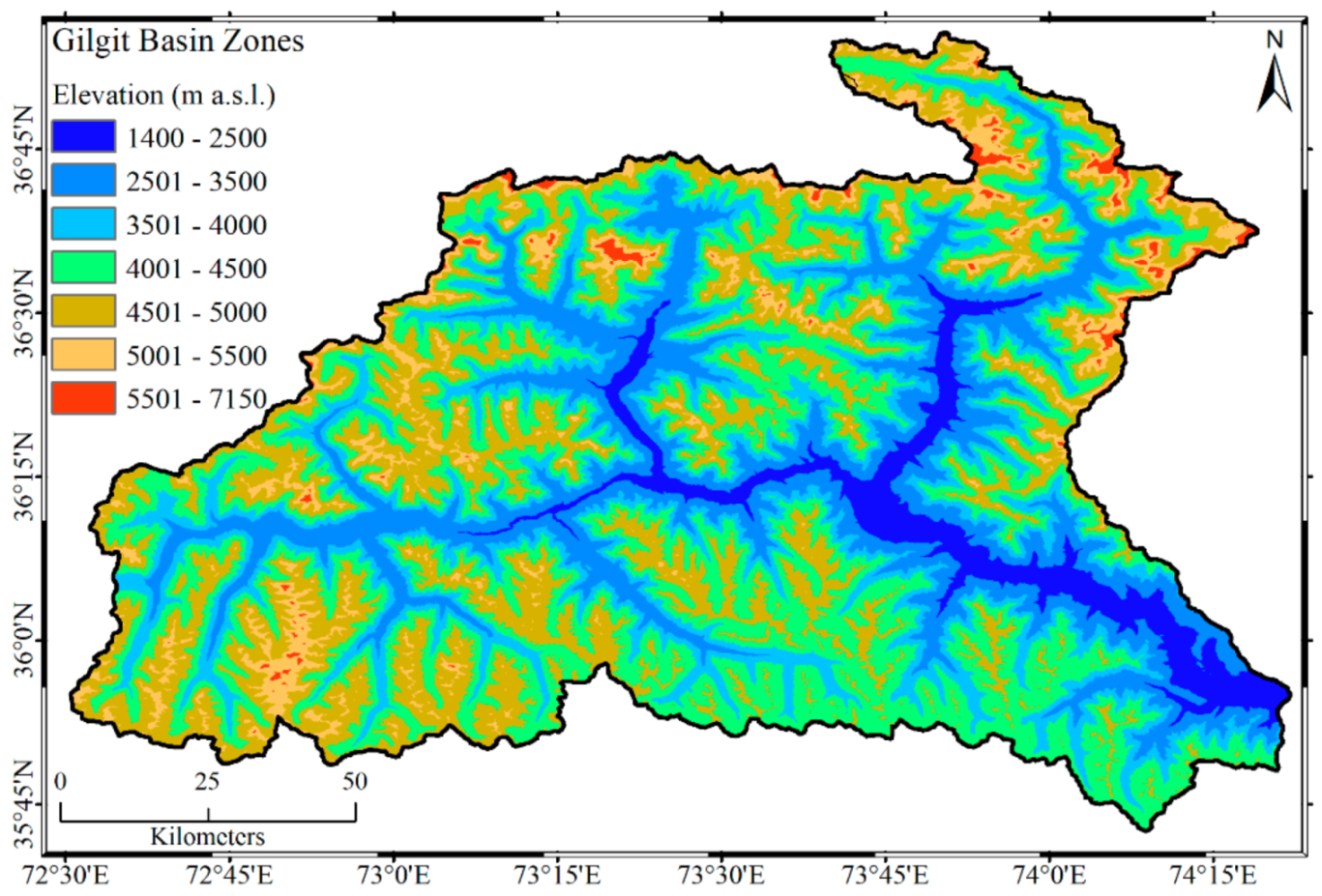
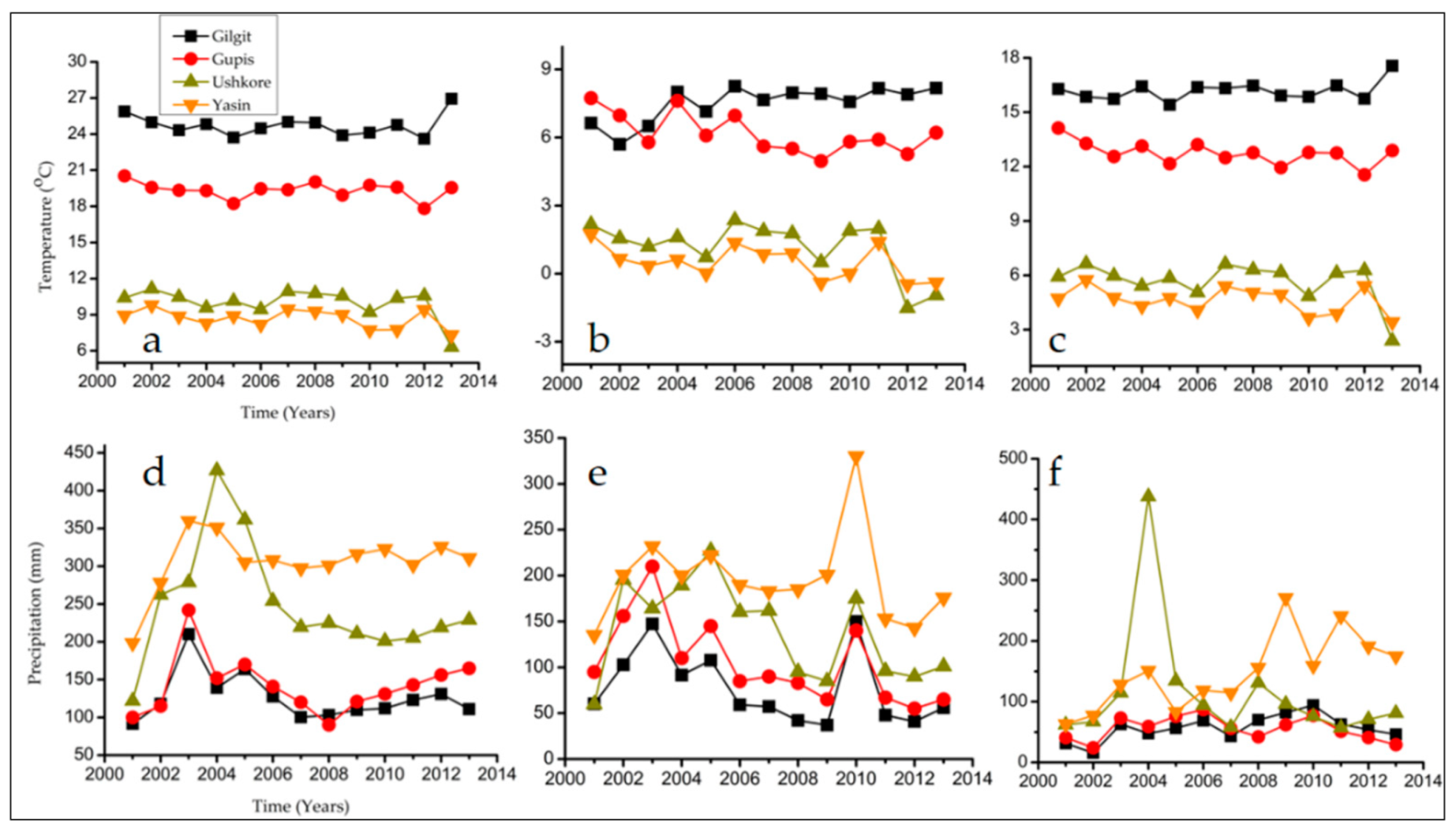
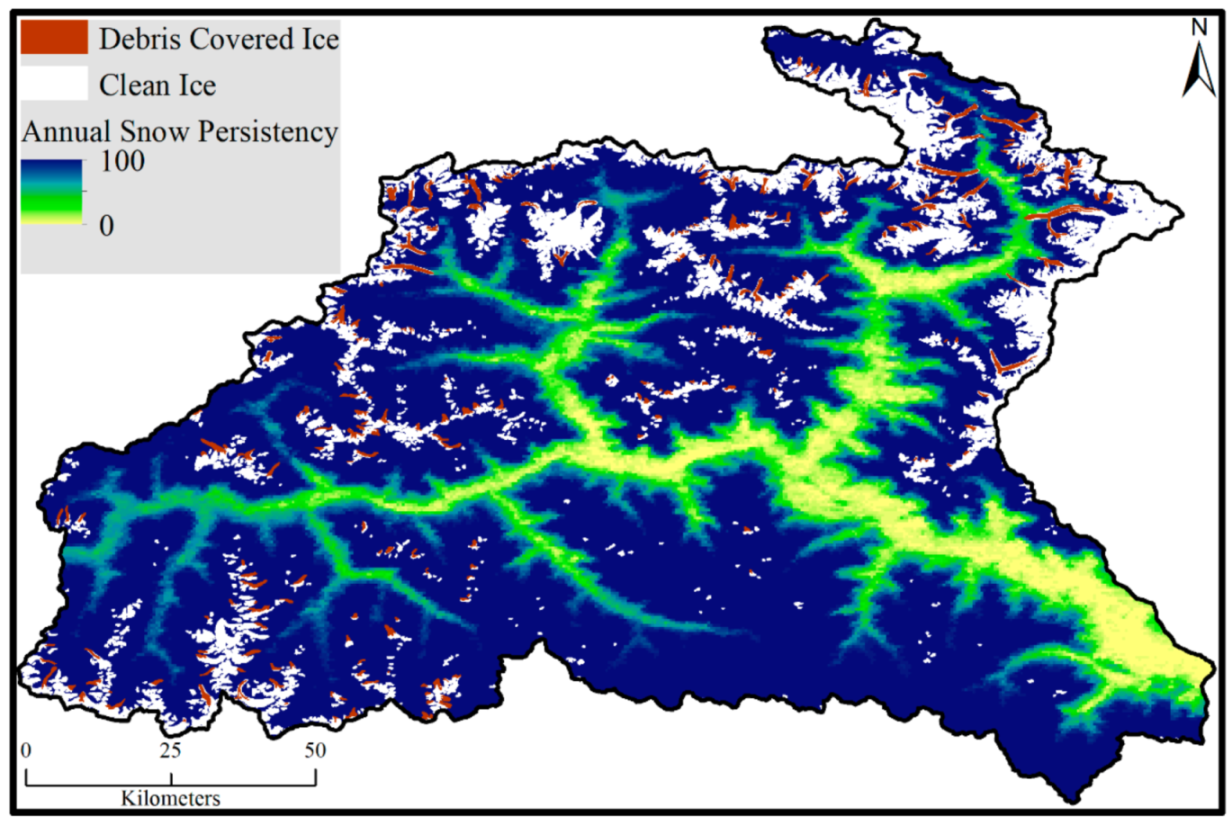
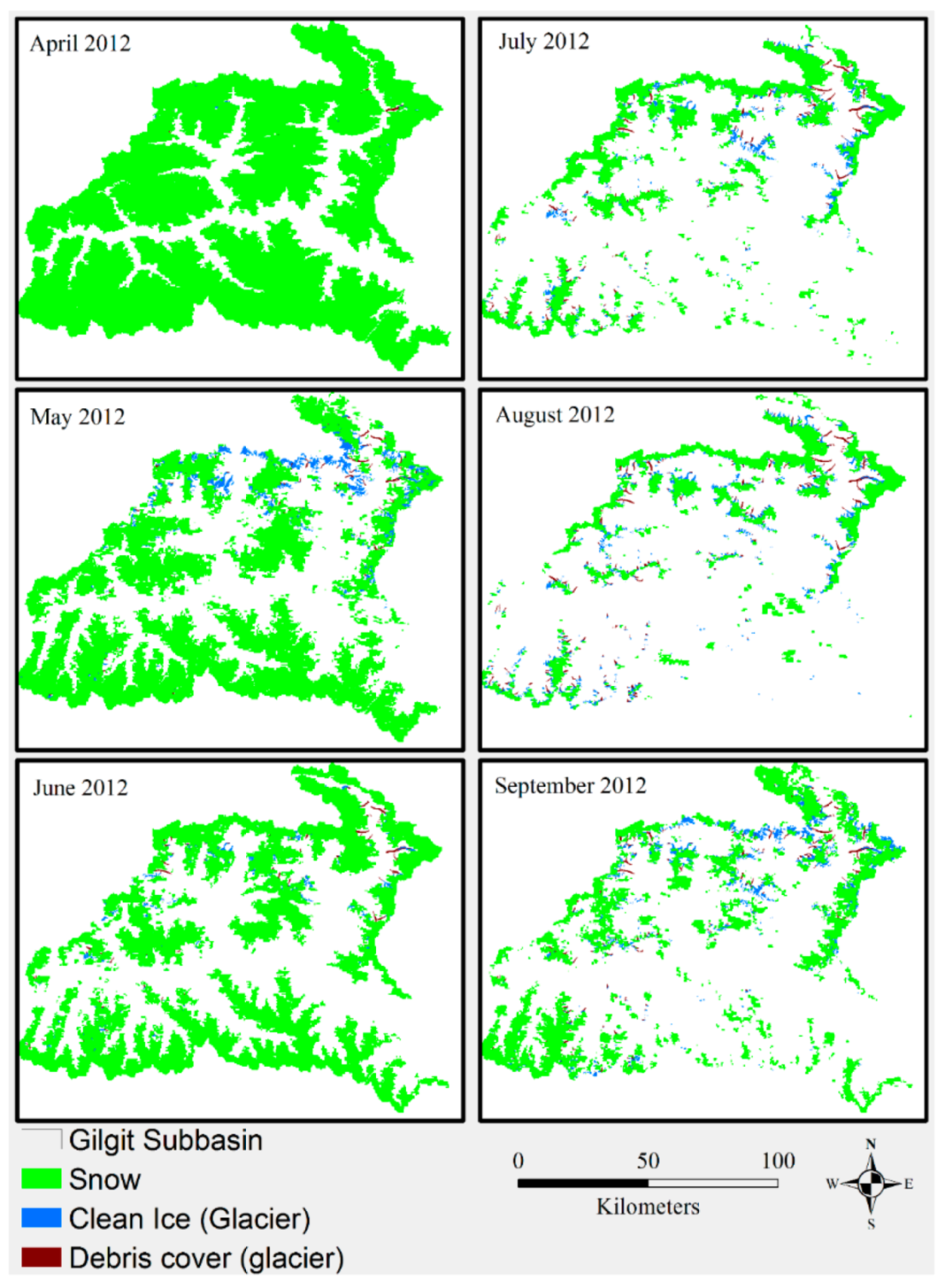
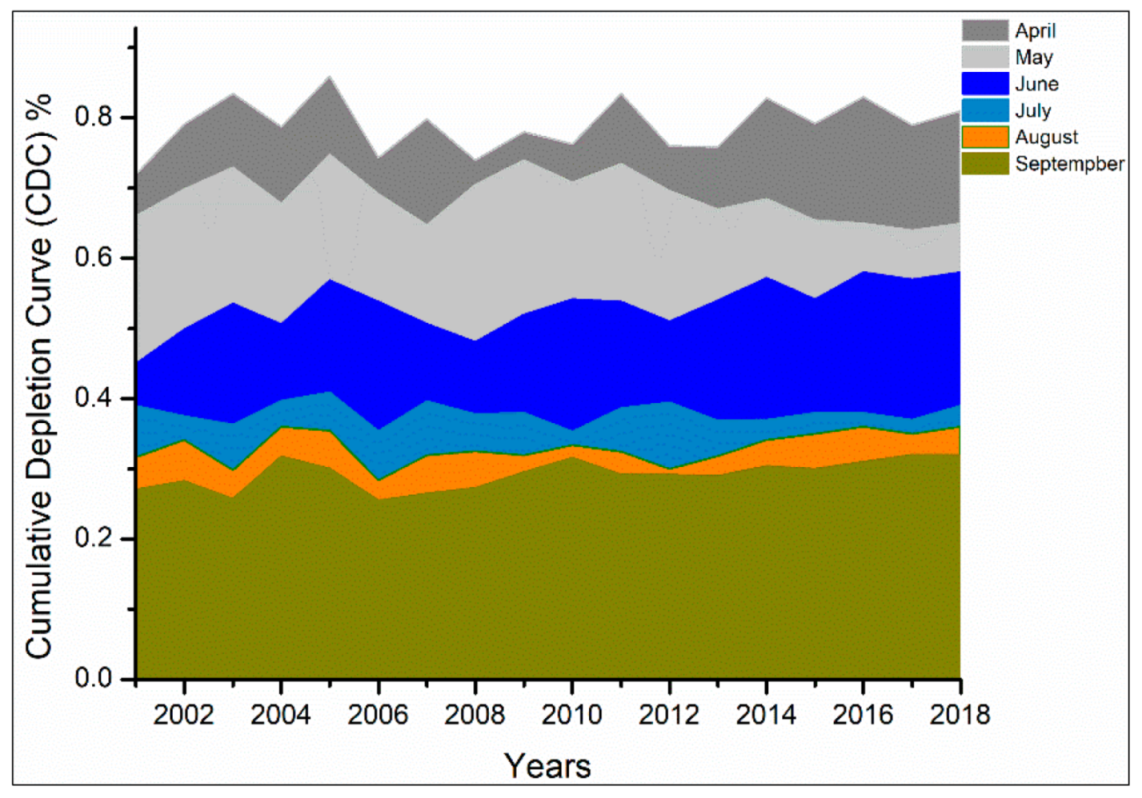
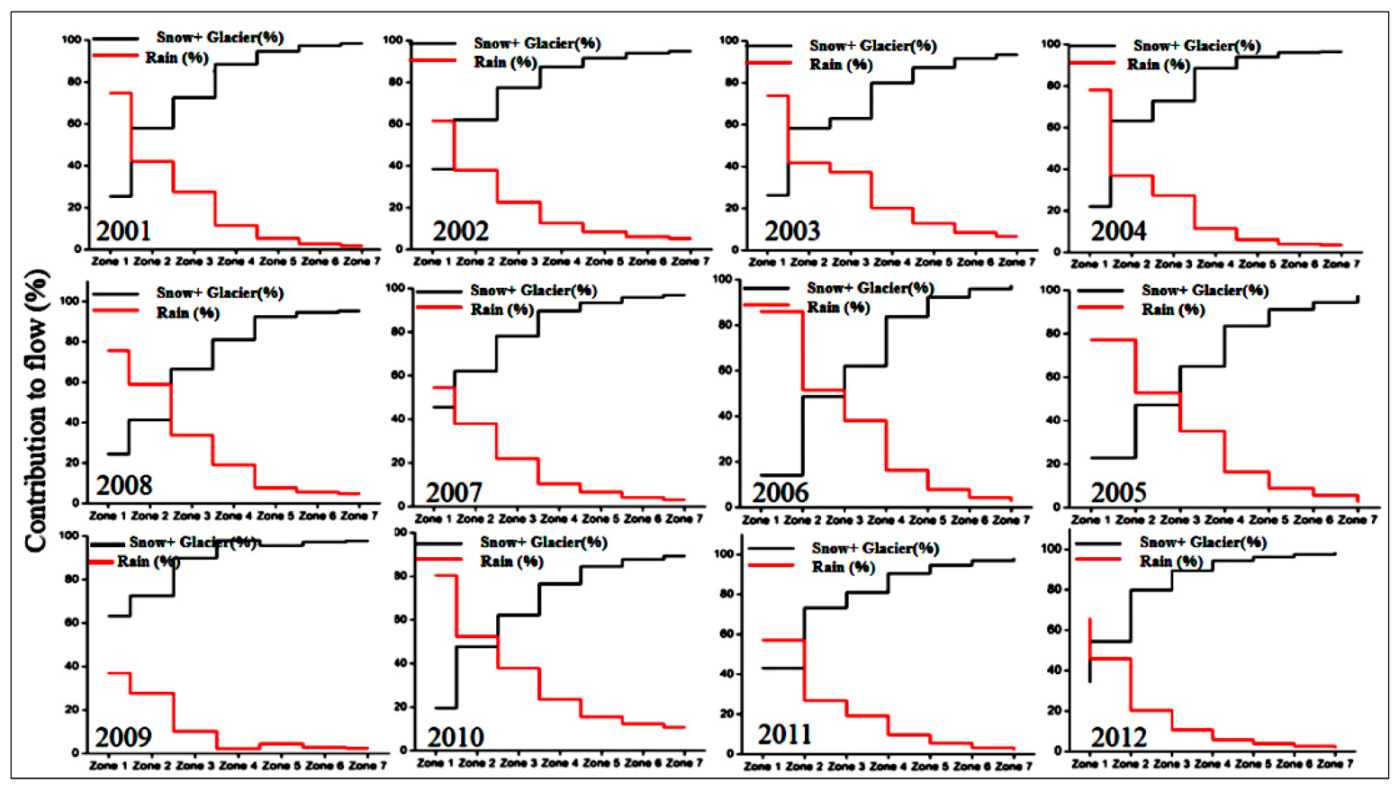

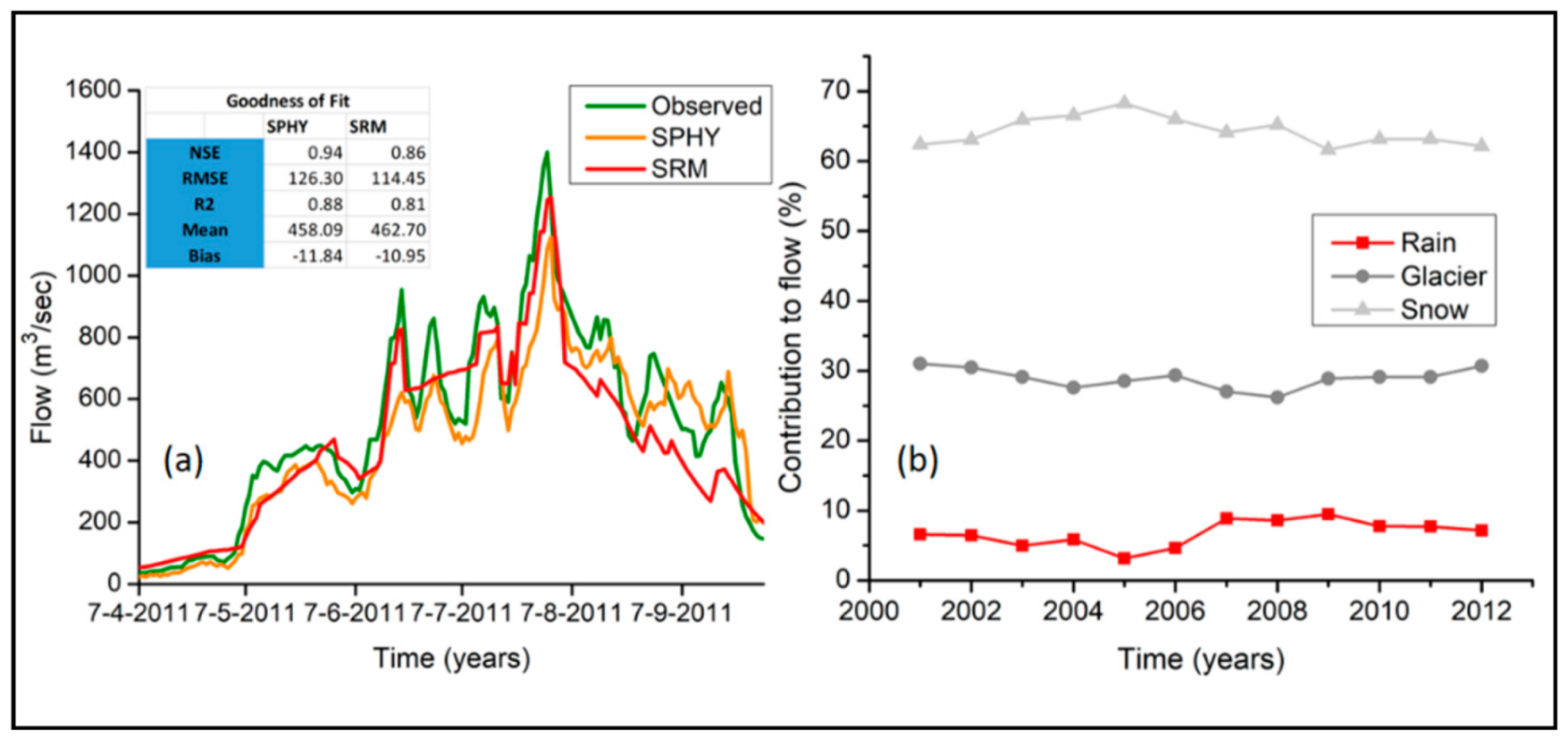
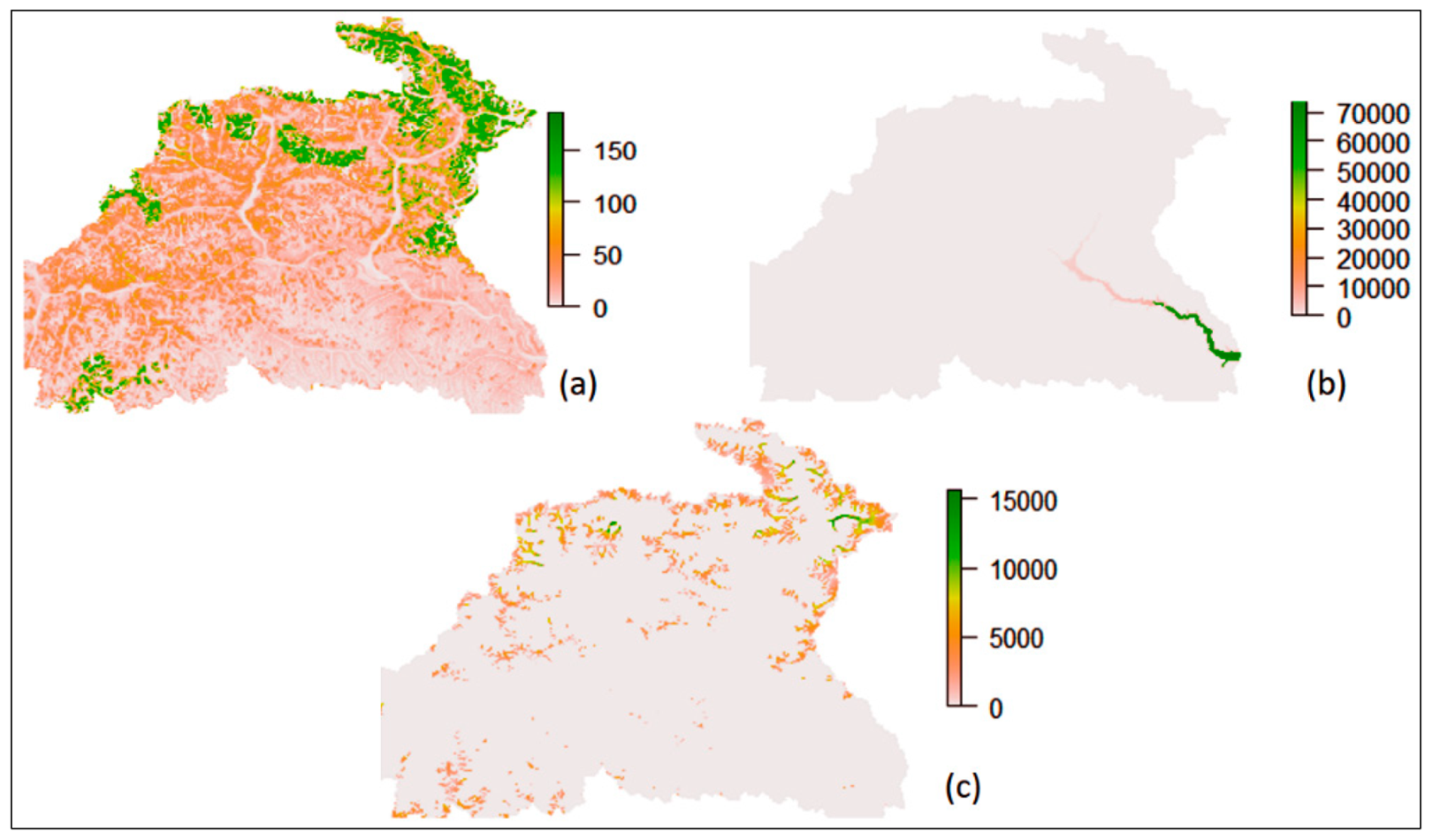
| Sr. # | Maps | Database | Spatial Resolution/Projection | (User Defined) |
|---|---|---|---|---|
| 1 | DEM | SRTM-DEM | 90 m | Gilgit, |
| 2 | LandUse | Globe cover Landuse | 300 m | Gupis |
| 3 | Latitudes | Latitude | Yasin, | |
| 4 | * root_wilt 1 | HiHydroSoil | Ushkore | |
| 5 | root_field 2 | HiHydroSoil | 800 m | |
| 6 | root_sat 3 | HiHydroSoil | 800 m | |
| 7 | root_Ksat 4 | HiHydroSoil | 800 m | |
| 8 | root_dry | HiHydroSoil | 800 m | |
| 9 | * sub_field | HiHydroSoil | 800 m | |
| 10 | sub_sat | HiHydroSoil | 800 m | |
| 11 | sub_ksat | HiHydroSoil | 800 m | |
| 12 | slope | HiHydroSoil | 800 m | |
| 13 | GlacierFrac | 5 RGI.5 | EPSG 4326 | |
| 14 | GlacierFracCI | RGI.5 | EPSG 4326 | |
| 15 | GlacierFracDC | RGI.5 | EPSG 4326 | |
| 16 | Outlets | Hydrosheds | EPSG 4326 | |
| 17 | Rivers | Hydrosheds | EPSG 4326 |
| Zone | Elev. Range | Mean Elev. (m) | Zone Area (km2) | Climatic Stations |
|---|---|---|---|---|
| 1 | 1460–2500 | 1980 | 692 | Gilgit, Gupis |
| 2 | 2500–3500 | 3000 | 2076 | Yasin, Ushkore |
| 3 | 3500–4000 | 3750 | 2252 | 3 (extrapolation) |
| 4 | 4000–4500 | 4250 | 3798 | 4 |
| 5 | 4500–5000 | 4750 | 3057 | 5 |
| 6 | 5000–5500 | 5250 | 747 | 6 |
| 7 | 5500–7150 | 6325 | 137 | 7 |
| Parameters | Parameters for Each Altitudinal Zones | ||||||
|---|---|---|---|---|---|---|---|
| 1(1460–2500) | 2(2500–3500) | 3(3500–4000) | 4(4000–4500) | 5(4500–5000) | 6(5000–5500) | 7(5500–7150) | |
| Lapse Rate (°C/100 m) | (Gilgit + Gupis) | (Ushkore + Yasin) | 0.42–0.53 | 0.42–0.53 | 0.42–0.53 | 0.42–0.53 | 0.42–0.53 |
| Tcrit (°C) | 0 | 0 | 0 | 0 | 0 | 0 | 0 |
| CS | 0.32–0.47 (April–May) 0.5–0.1 (June–September) | 0.32–0.47 (April–May) 0.5–0.1 (June–September) | 0.32–0.47 (April–May) 0.5–0.1 (June–September) | 0.32–0.47 (April–May) 0.5–0.1 (June–September) | 0.32–0.47 (April–May) 0.5–0.1 (June–September) | 0.32–0.47 (April–May) 0.5–0.1 (June–September) | 0.32–0.47 (April–May) 0.5–0.1 (June–September) |
| CR | 0.38–0.6 (May–July) 0.38–0.12 (Aug–September) | 0.38–0.6 (May–July) 0.38–0.12 (August–September) | 0.38–0.6 (May–July) 0.38–0.12 (August–September) | 0.38–0.6 (May–July) 0.38–0.12 (August–September) | 0.38–0.6 (May–July) 0.38–0.12 (August–September) | 0.38–0.6 (May–July) 0.38–0.12 (August–September) | 0.38–0.6 (May–July) 0.38–0.12 (August–September) |
| RCA | 0 (May and September) 1 (June–August) | 0 (May and September) 1 (June–August) | 0 (May and September) 1 (June–August) | 0 (May and September) 1 (June–August) | 0 (May and September) 1 (June–August) | 0 (May and September) 1 (June–August) | 0 (May and September) 1 (June–August) |
| XC | 1.03 (April–July) 1.02–0.94 (August–September) | 1.03 (April–July) 1.02–0.94 (August–September) | 1.03 (April–July) 1.02–0.94 (August–September) | 1.03 (April–July) 1.02–0.94 (August–September) | 1.03 (April–July) 1.02–0.94 (August–September) | 1.03 (April–July) 1.02–0.94 (August–September) | 1.03 (April–July) 1.02–0.94 (August–September) |
| YC | 0.002 | 0.002 | 0.002 | 0.002 | 0.002 | 0.002 | 0.002 |
| DDF | 0.4–0.5 (April–May) 0.75 (June–August) 0.1 (September) | 0.4–0.5 (April–May) 0.75 (June–August) 0.1 (September) | 0.4–0.5 (April–May) 0.75 (June–August) 0.1 (September) | 0.4–0.5 (April–May) 0.75 (June–August) 0.1 (September) | 0.4–0.5 (April–May) 0.75 (June–August) 0.1 (September) | 0.4–0.5 (April–May) 0.75 (June–August) 0.1 (September) | 0.4–0.5 (April–May) 0.75 (June–August) 0.1 (September) |
| Description | Symbol and Units | Calibrated Values | Optimum Value | Kc Values | Land-Use Classes |
|---|---|---|---|---|---|
| Initial snow | Snowini (mm) | Map ** | Map ** | 11 | Post-flooding |
| Snow stored in snowpack | SnowWatStor (mm) | Map ** | Map ** | 14 | Rainfed croplands |
| Degree Day Factor for snow | DDFS (mm/°C /Day) | 3–6 | 6 | 20 | Mosaic cropland (50–70%) |
| Glacier fraction Parameter | GlacFrac (mm/°C /Day) | 0.90 | 0.80 | 30 | Mosaic vegetation |
| Degree Day Factor for debris free glacier | DDFG (mm/°C /Day) | 5–8 | 8 | 100 | Closed to open |
| Degree Day Factor for Debris-covered Glacier | DDFDG (mm/°C /Day) | 2–4.5 | 2.5 | 110 | Grassland (20–50%) |
| Routing Recession coefficient | Kx | 0.5–0.9 * | 0.85 | 140 | herbaceous vegetation |
| Base flow Recession coefficient | alphaGW and deltaGW | 1 * and 0.5 * | 0.003 and 4 | 150 | Sparse (<15%) vegetation |
| 200 | Bare areas | ||||
| 210 | Water bodies | ||||
| 220 | Permanent snow and ice |
| Seasons | RCP 4.5 | RCP 8.5 | ||||
|---|---|---|---|---|---|---|
| Can-ESM2 | (2010–2039) | (2040–2069) | (2070–2099) | (2010–2039) | (2040–2069) | (2070–2099) |
| Change in Avg. Summer Temp. (°C) | 1.7 ** | 1.3 | 0.7 *** | 2.4 *** | 2.1 * | 2.6 * |
| Change in Summer (April–Sep) Flow (%) | Change in Summer Flow (April–Sep) (%) | |||||
| 2010 | 19.2 * | 6.7 ** | 6.9 * | 13.03 | 16.9 | 21.06 |
| 2011 | 15.07 | 14.7 * | 4.8 * | 8.4 | 12.6 | 17.5 |
| 2012 | 15.6 ** | 8.8 | 5.1 * | 11.2 | 13.9 | 18.7 |
| Average Flow (%) | 10.87 | 10.06 | 5.6 ** | 16.42 | 14.5 | 19.08 |
| Nor-ESM1-M | ||||||
| Change in Avg. Summer Temp. (°C) | 0.8 ** | 0.2 | 0.8 * | 2.9 * | 1.9 * | 1.8 |
| Change in River Summer (April–Sep) Flow (%) | Change in River Summer (April–Sep) Flow (%) | |||||
| 2010 | 7.5 | 2.3 | 7.4 | 15.7 | 10.6 | 10.2 |
| 2011 | 4.4 | 3.8 | 5.4 | 20.9 | 10.7 | 9.4 |
| 2012 | 5.54 | 1.97 | 5.5 | 17.9 | 12.6 | 11.7 |
| Average Flow (%) | 5.81 | 2.69 | 6.1 | 18.2 | 11.3 | 10.43 |
© 2020 by the authors. Licensee MDPI, Basel, Switzerland. This article is an open access article distributed under the terms and conditions of the Creative Commons Attribution (CC BY) license (http://creativecommons.org/licenses/by/4.0/).
Share and Cite
Latif, Y.; Ma, Y.; Ma, W.; Muhammad, S.; Adnan, M.; Yaseen, M.; Fealy, R. Differentiating Snow and Glacier Melt Contribution to Runoff in the Gilgit River Basin via Degree-Day Modelling Approach. Atmosphere 2020, 11, 1023. https://doi.org/10.3390/atmos11101023
Latif Y, Ma Y, Ma W, Muhammad S, Adnan M, Yaseen M, Fealy R. Differentiating Snow and Glacier Melt Contribution to Runoff in the Gilgit River Basin via Degree-Day Modelling Approach. Atmosphere. 2020; 11(10):1023. https://doi.org/10.3390/atmos11101023
Chicago/Turabian StyleLatif, Yasir, Yaoming Ma, Weiqiang Ma, Sher Muhammad, Muhammad Adnan, Muhammad Yaseen, and Rowan Fealy. 2020. "Differentiating Snow and Glacier Melt Contribution to Runoff in the Gilgit River Basin via Degree-Day Modelling Approach" Atmosphere 11, no. 10: 1023. https://doi.org/10.3390/atmos11101023
APA StyleLatif, Y., Ma, Y., Ma, W., Muhammad, S., Adnan, M., Yaseen, M., & Fealy, R. (2020). Differentiating Snow and Glacier Melt Contribution to Runoff in the Gilgit River Basin via Degree-Day Modelling Approach. Atmosphere, 11(10), 1023. https://doi.org/10.3390/atmos11101023










